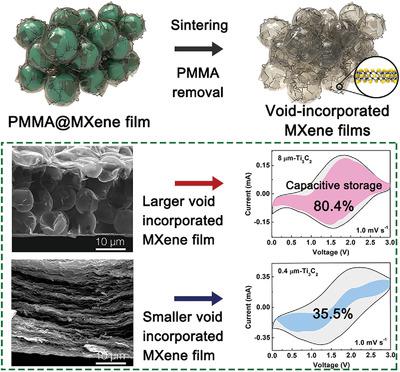当前位置:
X-MOL 学术
›
Adv. Mater. Interfaces
›
论文详情
Our official English website, www.x-mol.net, welcomes your
feedback! (Note: you will need to create a separate account there.)
Controlled High‐Capacity Storage of Lithium‐Ions Using Void‐Incorporated 3D MXene Architectures
Advanced Materials Interfaces ( IF 4.3 ) Pub Date : 2020-06-25 , DOI: 10.1002/admi.202000734 Gyu Duk Min 1 , Myeong Gyun Nam 1 , Dongjae Kim 2 , Min Jun Oh 1 , Joon Hyung Moon 1 , Woo‐Jae Kim 3 , Juhyun Park 4 , Pil J. Yoo 1
Advanced Materials Interfaces ( IF 4.3 ) Pub Date : 2020-06-25 , DOI: 10.1002/admi.202000734 Gyu Duk Min 1 , Myeong Gyun Nam 1 , Dongjae Kim 2 , Min Jun Oh 1 , Joon Hyung Moon 1 , Woo‐Jae Kim 3 , Juhyun Park 4 , Pil J. Yoo 1
Affiliation

|
MXene, an example of 2D transition metal carbides, has recently been explored as an energy storage material for batteries or supercapacitors due to its high electrical conductivity and tunability of functional moieties. As with other 2D nano‐materials, however, attempts to harness MXene‐based electrodes have been limited by deterioration in mass transfer owing to self‐stacking and aggregation problems of MXenes. Here, means of creating 3D‐structured MXene films having voids of controlled size using templated co‐assembly between MXene nanosheets and monodisperse colloidal particles are presented. Using a 3D‐structured MXene‐only film incorporating microscale voids as a thin‐film electrode for Li‐ion batteries yield an initial specific capacity of 435.4 mAh g−1 at a current density of 0.01 A g−1 and highly extended cyclic stability persisting 1200 cycles, approaching the reported theoretical capacity of MXene even without employing any binder or conductive species. Electrochemical analyses reveal that the improved specific capacity is attributable to enhanced contribution of pseudo‐capacitive Li‐storage compared to diffusion‐mediated capacity, as incorporated voids tend to facilitate ionic transport into the interior region of the MXene films. Therefore, this work offers a concrete understanding to realize improved electrochemical performances of 2D nanomaterial‐based electrodes, especially in the form of free‐standing thin films.
中文翻译:

使用Void集成的3D MXene体系结构控制锂离子的大容量存储
MXene是2D过渡金属碳化物的一个示例,由于其高电导率和功能部分的可调性,最近已被探索为电池或超级电容器的储能材料。但是,与其他2D纳米材料一样,由于MXene的自堆积和聚集问题,传质变差限制了利用MXene基电极的尝试。在这里,介绍了使用MXene纳米片和单分散胶体颗粒之间的模板共组装来创建具有受控尺寸空隙的3D结构MXene膜的方法。使用3D结构的仅包含MXene的MXene薄膜作为锂离子电池的薄膜电极,在0.01 A g -1的电流密度下可产生435.4 mAh g -1的初始比容量和高度扩展的循环稳定性,可持续1200个循环,即使不使用任何粘合剂或导电物质,也达到了报道的MXene的理论容量。电化学分析表明,与扩散介导的容量相比,比电容的提高归因于伪电容式锂存储的贡献增加,因为掺入的空隙倾向于促进离子向MXene薄膜内部区域的迁移。因此,这项工作为实现2D纳米材料基电极的电化学性能的改善提供了具体的理解,尤其是以自支撑薄膜的形式。
更新日期:2020-06-25
中文翻译:

使用Void集成的3D MXene体系结构控制锂离子的大容量存储
MXene是2D过渡金属碳化物的一个示例,由于其高电导率和功能部分的可调性,最近已被探索为电池或超级电容器的储能材料。但是,与其他2D纳米材料一样,由于MXene的自堆积和聚集问题,传质变差限制了利用MXene基电极的尝试。在这里,介绍了使用MXene纳米片和单分散胶体颗粒之间的模板共组装来创建具有受控尺寸空隙的3D结构MXene膜的方法。使用3D结构的仅包含MXene的MXene薄膜作为锂离子电池的薄膜电极,在0.01 A g -1的电流密度下可产生435.4 mAh g -1的初始比容量和高度扩展的循环稳定性,可持续1200个循环,即使不使用任何粘合剂或导电物质,也达到了报道的MXene的理论容量。电化学分析表明,与扩散介导的容量相比,比电容的提高归因于伪电容式锂存储的贡献增加,因为掺入的空隙倾向于促进离子向MXene薄膜内部区域的迁移。因此,这项工作为实现2D纳米材料基电极的电化学性能的改善提供了具体的理解,尤其是以自支撑薄膜的形式。











































 京公网安备 11010802027423号
京公网安备 11010802027423号